
VW e-Up! Review

Introduction
Electric cars are hitting the market thick and fast these days, but it hasn’t always been so. Almost a decade ago there were but a few pioneers, and the Volkswagen E-Up is one of them. It was released in 2013, but the fact that it’s still going strong today – and is still a great EV option – is testament to how far ahead of its time it was. A refresh in 2019 has helped, with a new battery that doubled its range on a single charge and a few new safety features. That’s helped keep it competitive against cars like the Mini Electric, Renault Zoe and Seat Mii Electric.
Review Sections
Select's rating score* - 3.7 / 5
At a Glance
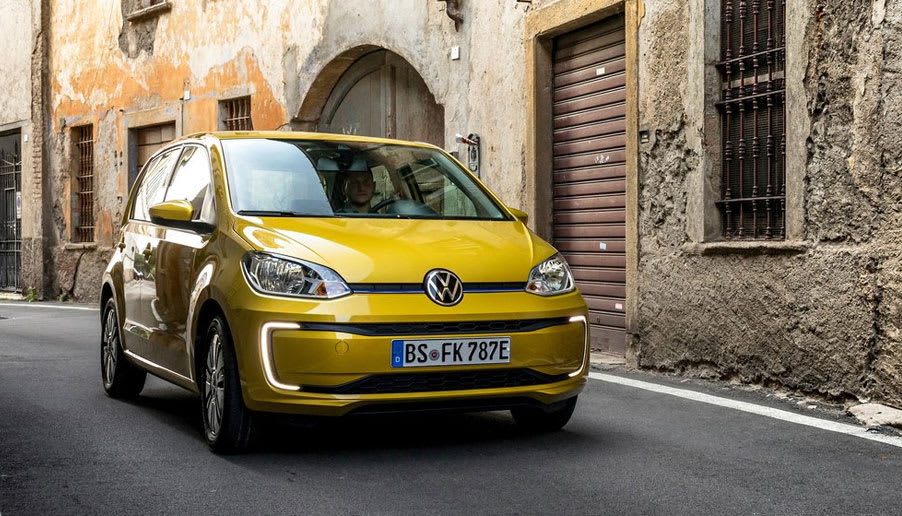
The E-Up is an electric version of the regular Volkswagen Up, a small city car that crams a lot of interior space into a small package. With five doors and space inside for four, plus a boot that hasn’t been compromised by the need for batteries, it can cope with everyday urban life very well. Practicalities aside, it’s also impressive to drive, mixing comfort and agile handling very nice. It comes with plenty of equipment too, and a single charge of the battery will get you up to 159 miles of range. Perhaps most appealingly, it has low leasing rates compared with a lot of its rivals.
Key Features
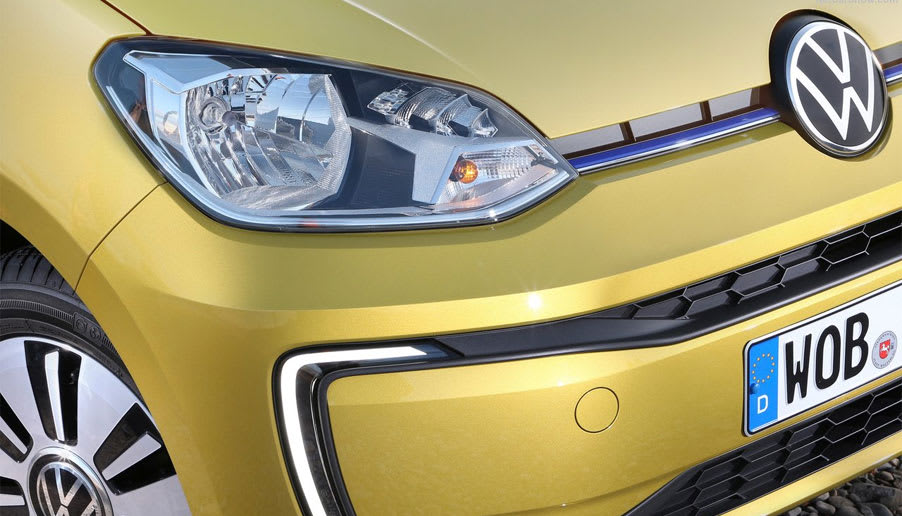
In a deepening sea of EV rivals, the E-Up is pleasantly simple to understand. One trim level. One battery choice. But quite few customisation options, and plenty of features as standard. This is a straightforward urban runabout that will happily house four adults and a small amount of luggage, and will do more than 150 miles before you need to plug it in to charge. You can do that at home if you’ve got space, or at a public charger. Inside you’ve got a comfortable interior, albeit one that feels rather dated compared to newer rivals, and a generous level of specification; it does sit at the top of the wider Up range, after all. To drive, the electric powertrain gives plenty of zip to acceleration, and handling is surprisingly engaging and fun, while the ride quality is also comfortable.
Range & Batteries
The E-Up has a 36.8kWh lithium-ion battery, which is on the small side compared to a lot of rivals, but then this is a small and relatively affordable EV; something larger would push the price up. It gives you a range of up to 159 miles, according to official testing. Real-world range shouldn’t be too far below that, as long as you keep your driving predominantly urban; go out on the motorway and the range will drop.
Performance & Drive
You might not have high expectations for driving fun in a small EV, in which case you’ll be pleasantly surprised by the E-Up. The battery is mounted low in the car, which means a low centre of gravity, much to the benefit of handling. Sharp steering, and a feeling of overall agility means that if you do end up out on a faster, more flowing bit of road, you can have an engaging time. It’s no sports car – if you’re after proper fun then check out the petrol-powered Up GTI – but it’s better than it needs to be. Despite this though, it’s still comfortable for driver and passengers alike. Poor road surfaces are massaged nicely before their lumps and bumps make it to the Up’s occupants. VW has done an excellent job of judging the firmness of the suspension, which all too often on electric cars can be too stiff, due to the need to carry heavy electrical components. No such worries here.
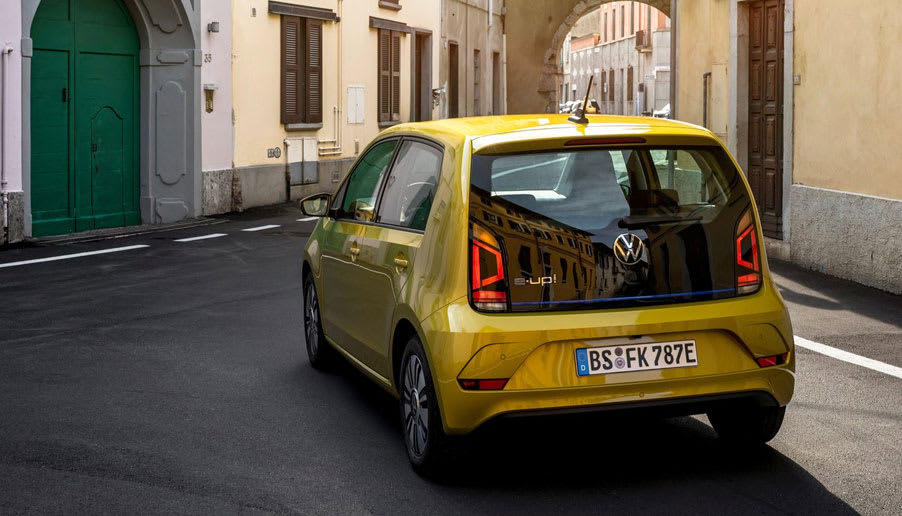
The electric motor in the E-Up makes 82 horsepower. That might not sound much, but when you factor in the diminutive size, as well as the fact that electric motors deliver maximum oomph straight away – rather than needing revs to build – it’s enough for peppy performance. It never feels like it’s lacking power around town, although it doesn’t feel quite as quick to accelerate when you get to higher speeds, such as on the motorway.
Three different driving modes can be selected via a rocker switch, which let you prioritise efficiency or performance. Two of these are Eco modes, which restrict the top speed and air conditioning to try and hang on to as much electricity as possible. They mean that performance isn’t as zippy, but they could be useful if you’ve forgotten to charge and need to eke out every last bit of juice. You can also change the amount of energy recovery that the car harvests when braking or coasting, which has an effect on the braking. It’s much like engine braking – the more recovery, the more the braking effect – and higher settings let you drive the car almost exclusively using the accelerator, which makes life a bit less stressful around town.
Charging
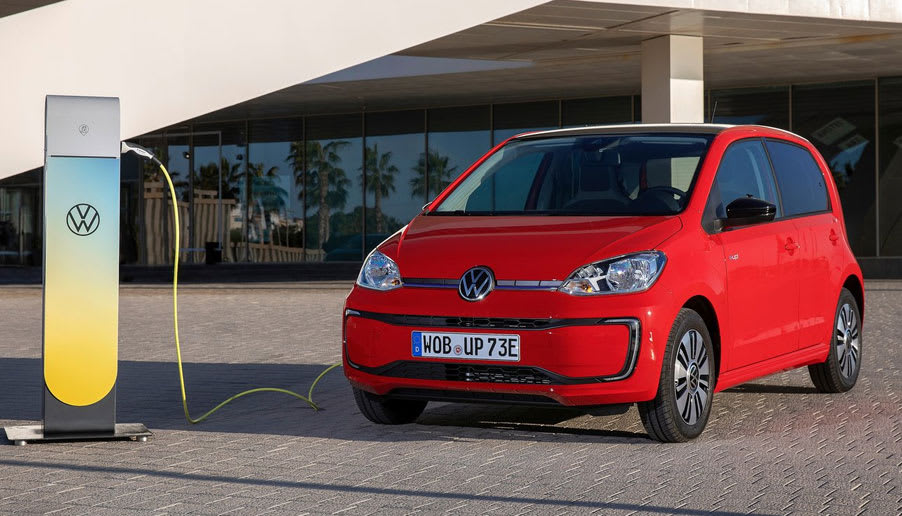
You can charge your VW E-Up from a home wallbox or a public charger, or even using a regular three-pin socket. It comes with two six-metre cables: a 16-amp AC cable for wallbox and public charging, and a 10-amp mains charging cable. If you use a three-pin socket, it’ll charge from empty in around 16 hours, or in 5.5 hours using a home AC charger at 7.2kW. A quick charge to 80% using a public DC fast charger takes about an hour at 40kW. There are more modern rival cars that will cope with faster charging speeds, but the relatively small capacity of the E-Up means the overall charging time isn’t that much longer.
Running Costs & Emissions
One of the E-Ups biggest plus points is its cost; leasing charges, at the time of writing, are pretty much unbeatable by any of the competition.
When it comes to day to day running, you’ll need to plug your car into the mains to charge your E-Up. However you do it, it’ll cost less than using conventional fuel, but it’s cheaper to charge at home than with a public charger. For the best results, charge overnight and sign up to a tariff that charges less at off-peak hours. When it comes to efficiency, and the electric equivalent of miles-per-gallon, the E-Up is rated at around 200kWh per mile.
As there are no polluting emissions, company car drivers will pay just 1% benefit-in-kind tax during 2021/22. The insurance premiums should be relatively low too; the E-Up sits in group 10 of 50, which is quite a bit higher than a regular Up (GTI model aside), but lower than a lot of electric rivals.
Interior & Technology
Volkswagen has kept the interior of the E-Up broadly the same as the regular Up, and that’s not a bad thing; it’s sensibly laid out, everything’s easy to reach and clear to understand with large dials ahead of the driver and plenty of buttons to change settings. It is getting on in years now, in terms of design and material choice, and there are plenty of more modern rivals that look and feel snazzier. All that said though, nothing is offensive or bad about the way that the E-Up looks and feels, and it’s all screwed together very well.
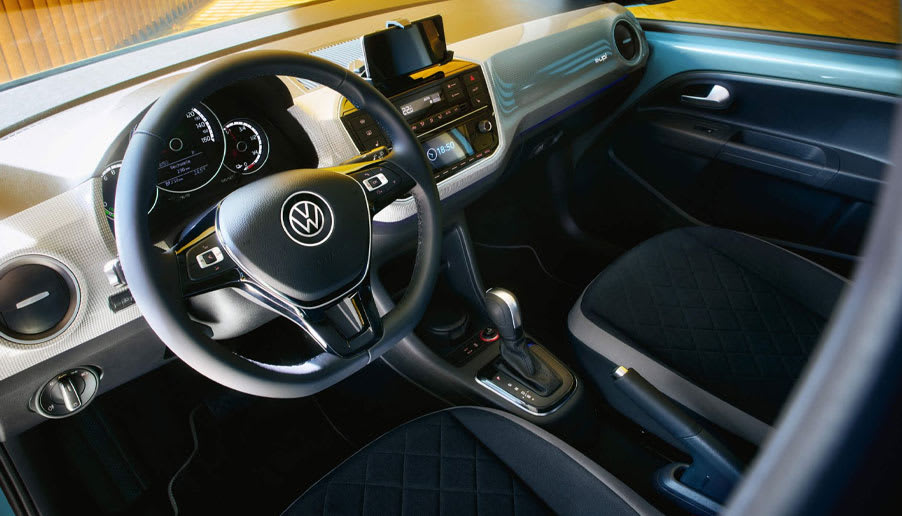
Rather than a touchscreen infotainment system, the E-Up utilises your smartphone for navigation and entertainment duties, which saves money and unnecessary tech. There’s a cradle for your handset built into the top of the dash, and a USB socket to keep the phone powered and connected. You can use a VW app to take advantage of some proprietary features, including a navigation system, but you’re better off just using regular music, podcast or navigation apps from your phone. There’s a built-in DAB radio and Bluetooth, as well as an auxiliary input and an SD card port.
Practicality & Boot Space
While the regular Up is available both as a three-door and five-door hatchback, the E-Up comes only in five-door form. That’s good news for practicality, as it allows rear-seat passengers much easier access. While it’s a very compact car there’s an impressive amount of room inside; you’ll easily fit four adults in. It’s worth noting, however, that it’s a strict four-seater, and there are rivals that will let you fit in five. In addition, headroom is slightly less than other models of up, as the need for battery storage has meant the rear seats are higher.
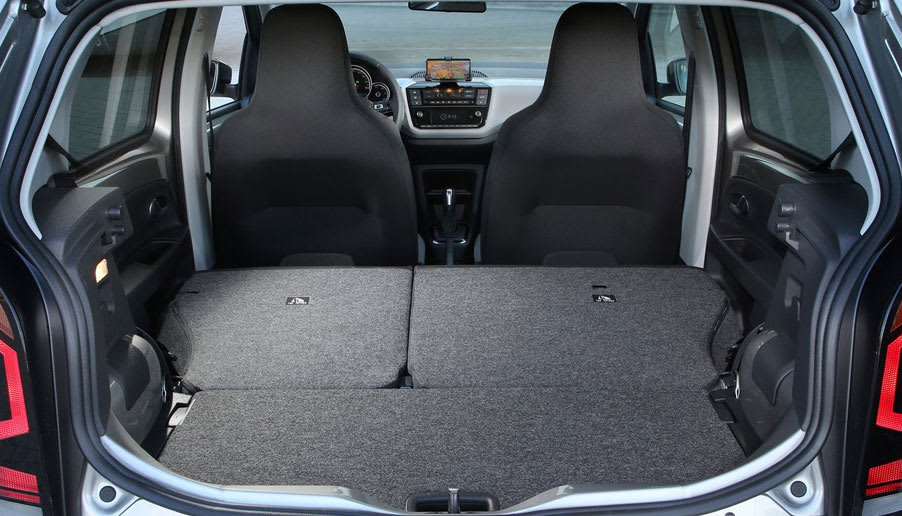
Boot space is good for the size of car, but again, there are other electric city cars that will give you more space. The E-Up has the same space as the regular Up, which means 251 litres of space. It’s enough for a decent haul of shopping but don’t expect much more than that. You can fold down the rear seats in a 60/40 split to give up to 959 litres of space for larger items, although there’s a big step between the boot floor and the folded seats.
General storage is also generous considering the size of car, with good sized door pockets up front but fairly titchy ones in the back. There’s just one cupholder up front, and one in the back behind the handbrake
Safety
The E-Up shares a rating with the regular Up, which was last tested by independent safety organisation Euro NCAP in 2019. It scored a disappointing three stars, which pales in comparison to numerous rivals. Part of this is due to its age, but also because of a lack of modern safety systems. There’s no automatic emergency braking, for example – something that all modern rivals have, and most as standard. You do get, however, front, side and curtain airbags and Isofix child seat mounting points in the back.
Options
There’s just one version of the E-Up, but it sits towards the top of the Up range and comes suitably well equipped. You’ll get 15-inch alloy wheels with low rolling resistance tyres, and some styling elements on the outside that are exclusive to the electric model. These comprise unique bumpers, front and rear, and a honeycomb front air intake, as well as blue stripes on the front grille and boot lid. There are LED running lights and E-Up badges on the outside too.
Inside you’ll find a leather-trimmed steering wheel, heated front seats and two-zone air conditioning, as well as a heated windscreen that can clear quickly in frosty weather. Cruise control, rear parking sensors and a rear-view camera.
Options include a selection of paint colours and a variable boot floor, which could let you flatten out the load space with the rear seats folded. Sadly for music lovers, the Beats music system that’s available in some other Up models isn’t available in the E-Up.
Rival Cars
When it comes to small electric city cars, there are an increasing number of options. The Seat Mii was the closest, and it’s essentially a rebadged version of the E-Up, but at the time of writing it was available only from stock, as Seat aren’t making them any more. That means you’ll want to consider the Renault Zoe, which has a bigger range but is larger. Similarly small options include the Honda E, which is very good and very stylish, but expensive and has a disappointingly small range. The same is true of the MINI Electric, although it’s a much more premium-feeling car, and fun to drive too. Other cars to check out include the Peugeot e-208 and the mechanically-similar Vauxhall Corsa-E, as well as the swish-looking Fiat 500e.
Verdict & Next Steps
In some ways, the Volkswagen e-Up is showing its age, most notably in its safety rating and the design of its interior. But in others, it’s still one of the very best electric city cars you can lease. Its compact size belies impressive practicality, and it’s both comfortable and fun to drive for a car of this type. Perhaps most importantly though, it’s very affordable compared to its rivals; at the time of writing, you could pick one up for less than £150 a month. For that kind of value for money, it’s very easy to overlook a few minor quibbles. It would still be a very attractive option at considerably more money.
Where to next?
- View latest Volkswagen e-Up! leasing deals - guide price from £143.99 per month inc VAT**
- Looking for a great leasing deal? Check out our incredible range of Special Offers
- New CAR Read our latest Reviews and find the right model for you
- Want to know more about leasing? Take a look at our comprehensive Leasing Guides
- Interested in everything motoring? Why not catch up on all the latest Car Leasing News.
*Score based on Select’s unique meta score analysis, taking into account the UK’s top five leading independent car website reviews of the Volkswagen e-Up!
**Correct as of 19/08/2021. Based on 9 months initial payment, 5,000 miles over a 48 month lease. Initial payment equivalent to 9 monthly payments or £1,295.89 - Ts and Cs apply. Credit is subject to status.



















